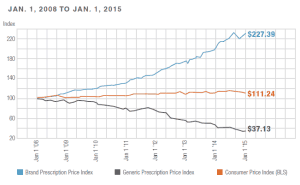The use of generic drugs in workers’ compensation is an effective and efficient method for controlling workers’ compensation costs. Notwithstanding recent headlines that suggest otherwise, this continues to be a successful tool in controlling the increase pressures place on programs seeking to remain competitive.
What are Generic Prescription Drugs?
The common perception of generic items being cheap or ineffective is simply not the case when it comes to pharmaceuticals. When discussing the issue of drugs, it merely refers to a drug product that is comparable to a brand/reference listed drug product in dosage form, strength, quality and performance characteristics, and intended use.
For example, a common brand name drug used in workers’ compensation for pain relief is “Percocet.” This is merely a combination of oxycodone and acetaminophen. The generic of this prescription drug has the same molecular combinations, and is required by the U.S. Food and Drug Administration to have the same effectiveness and bioequivalent range.
Are Generic Drug Costs Rising?
Until recently, the conventional wisdom has been that generic drugs are less expensive than their name brand counterparts. Some examples of this include the following headlines, which has sparked a media frenzy:
- Why Are Generic Drug Prices Shooting Up?; Forbes, February 27, 2015
- 5 Reasons Generic Drugs Cost so Much; ABC News, August 20, 2015
- Rising Cost Of Drugs: Where Do We Go From Here?; Healthaffair.org, August 31, 2015
The issue of rising generic prices as reported in the media is due primarily to two main drivers: a consolidation of companies who manufacture these drugs and a short-lived shortage of active ingredients necessary to make the medications. While it is true that the price of select generics has increased, the reality of the situation is not what one would think. As a whole, the average price of generics continues to be significantly lower when compared to their name brand counterparts.
A Reality Check on Generic Prescription Drugs
According to a data published in the Express Scripts Drug Trend Report, since 2008, the average price of brand name drugs has almost doubled, while the average price of generic drugs has been cut roughly in half. A clear illustration of this fact is found in their prescription drug price index, which graphs brand name prescriptions and generics in a similar way that the U.S. Consumer Price Index measures changes in the prices paid for a representative basket of goods and services. At the beginning of 2008, starting from a baseline index of about $100, this survey noted an increase in the average brand name prescription medications cost to $227.39, compared to an increase in inflation to $111.24 in the baseline. The average cost for generics has dropped from the $100 index in 2008 to $37.13 in 2015.
Using Generics to Reduce Work Comp Costs
Notwithstanding the media hype and spin, generic prescription drugs remain and effective way to control costs in a workers’ compensation program. The Drug Trend Report also determined it that for every 1% increase in generic fill rate, a payer can expect to reduce their overall prescription drug costs by as much as 2%. This is welcome news for most workers’ compensation programs as even a small reduction in costs can free up settlement reserves.
Conclusions
Generic prescription drugs create a win-win in any workers’ compensation program. In terms of serving injured workers, they provide effective pain relief and efficient medical care. They also allow workers’ compensation programs to reduce costs and promote efficiency.
Author Michael Stack, Principal, COMPClub, Amaxx LLC. He is an expert in workers compensation cost containment systems and helps employers reduce their work comp costs by 20% to 50%. He works as a consultant to large and mid-market clients, is co-author of Your Ultimate Guide To Mastering Workers Comp Costs, a comprehensive step-by-step manual of cost containment strategies based on hands-on field experience, and is founder of COMPClub, an exclusive member training program on workers compensation cost containment best practices. Through these platforms he is in the trenches on a working together with clients to implement and define best practices, which allows him to continuously be at the forefront of innovation and thought leadership in workers’ compensation cost containment. Contact: mstack@reduceyourworkerscomp.com.
©2016 Amaxx LLC. All rights reserved under International Copyright Law.
Do not use this information without independent verification. All state laws vary. You should consult with your insurance broker, attorney, or qualified professional.







